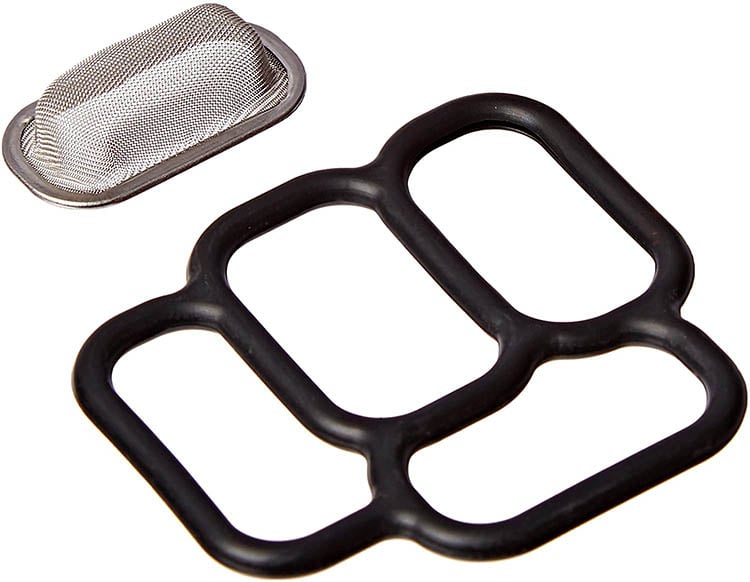Ultimate VTEC Solenoid Guide
Are you having issues with the ever-popular VTEC system in your beloved Honda? If so, the VTEC solenoid might be the part to blame. Join us as we take a look at the most common VTEC solenoid issues and the ways of fixing them.

- Introduction
- What does the VTEC solenoid do?
- What are the symptoms of a bad VTEC solenoid?
- Where is the VTEC solenoid located?
- How to test a VTEC Solenoid
- Removing a VTEC solenoid
- How much does a VTEC solenoid cost?
- Conclusion
Introduction
Although we’re not shy when it comes to poking fun at the Honda fanboys here at Drifted, we certainly know how frustrating reliability issues can be.
I mean, we mostly own Nissan’s – that should be all you need to know!
Jokes aside, despite Honda often being at the forefront of reliable performance, they’re not getting any younger, and many enthusiasts have experienced issues with their VTEC solenoids along the way.
Way back in the 1960s, it was the latest fad to begin squeezing as much power as possible out of the engines on the market.
Further research led to some significant breakthroughs in the automotive world, and manufacturers soon realized that by manually adjusting the ignition timing and valve lash, improved performance was easily achievable.
As time progressed, the 1970s would see Alfa Romeo introduce a first of its kind technology into their newly-launched Alfa Romeo Spider 2000 – a mechanical variable-valve timing (VVT) system.
From 1983 onwards, all Alfa Romeo Spider models began to integrate electronic VVT into their cars, and other manufacturers soon followed suit.
It wasn’t until 1989 that Honda got in on the VVT game and introduced their version – VTEC, YO!
Unlike Nissan’s NVCS system at the time, which alters the phasing of the camshaft, VTEC instead switches to a separate cam profile at high engine speeds, which improves the peak power.
The much-loved B16A engine was the first in the line of Honda’s B Series VTEC engines, with owners of some of the best cars in the history of the sport compact industry like the Civic, CRX, and Integra soon becoming renowned for yelling ‘VTEC JUST KICKED IN, YO!’ at every given opportunity. (Sorry, we couldn’t resist!)
What does the VTEC solenoid do?
Given that VTEC is Honda’s fancy name for their variable valve timing system, its job is to advance the timing when extra power is necessary for the upper rev range.
The role of the VTEC solenoid is to control the flow of oil to the internal galleries of the overhead camshaft.

Honda’s VTEC solenoid works alongside the oil pressure switch, and employs the camshaft’s high-performance setting together.
Given the age of many Honda’s using the much-loved VTEC system, oil pressure issues may begin to arise over time due to several potential reasons.
Despite the VTEC system being famed for its durability, the chances are that you’re going to need to change your solenoid eventually. But don’t panic, as thankfully, it can be far less costly than it sounds.
What are the symptoms of a bad VTEC solenoid?
The most likely scenario with a VTEC solenoid failure is when you get a check engine light, and the car will likely go into limp mode, often leaving you fearing the worst.
Thankfully, even when the VTEC solenoid is no longer working correctly, you’re able to leave it as it is or unplug it until you’re able to get it fixed, which we recommend doing sooner rather than later.
While this won’t provide a higher lift cam, and the engine won’t perform nearly as efficiently, especially in the upper revs, it will not cause any real engine damage in the short term.

With that said, we wouldn’t recommend going without the VTEC solenoid for the long term, as it will leave the engine running rich, which can lead to a rough engine idle and a decrease in fuel economy.
Let’s be real, what’s the point of a Honda that doesn’t have VTEC?
Despite the mentioned engine issues being the best way to know if your solenoid is likely to be changed, you may also find that your engine is dripping oil, often caused by a worn gasket on the solenoid.
Although replacing the gasket can fix this issue, we’ve seen plenty of owners change the gasket just for the solenoid or oil pressure switch to go wrong soon after, so we’d typically recommend replacing the entire solenoid for around the same price.
Where is the VTEC solenoid located?
As you’ve probably guessed, the VTEC solenoid is found in different locations depending on your Honda model, so it’s worth checking Google and YouTube for advice on finding its place in your engine bay.
We’ve found that this video gives the best view of what you’re looking for and where you’ll find the VTEC solenoid in the engine bay of a Honda CRV:
And here’s another example for the K24 owners out there.
If you own a Honda Prelude, this example is for you.
For some models, you may require jack stands to access the solenoid conveniently, so it’s worth checking before you go ahead with the task.
If you’re only looking to replace the VTEC solenoid gasket kit at present, you’re still going to need to remove the solenoid itself to access the gaskets.
How to test a VTEC Solenoid
It’s not always apparent right away as to whether it’s the OEM solenoid causing your issues, but here are a few common ways to narrow down the possibilities.
Oil Leaks
Sometimes it may be evident that something isn’t quite right with the VTEC solenoid if you’re experiencing an oil leak from around the unit, but this is likely to be down to a worn gasket.
Given the age of most VTEC systems, this is a common issue due to the rubber perishing over time. Although this isn’t a significant issue, we’d recommend getting it resolved as soon as possible before a substantial oil leak occurs.
We’ve seen many owners replace the gasket kit just for the solenoid to fail shortly after, so we’d recommend changing the solenoid itself while you’re already carrying out the task since it’s often around the same price.
Oil Pressure
If you’ve not got a leak, but you still suspect there may be issues, you can check the oil pressure of a hot engine using a mechanical gauge, where we’d hope to see around 30 psi.
Electronics/Ground
The next stage can be to check that the VTEC solenoid is grounded correctly using a multimeter, as shown in this video:
Error Codes
Assuming there are no visual issues and the solenoid is grounded, it’s time to investigate whether there are any error codes on the system, in which case you’ll need to use an engine code reader.
This step is likely to prove especially vital if you currently have an engine warning light displaying in your dashboard instrument cluster.
Although engine code readers are a handy tool to have and can be purchased for a reasonable price, you may also have luck asking a friend to borrow theirs.
If you’re in a rush, you may also wish to head to a local garage so that they can check the error codes for you.
The most common code that likely points to a VTEC malfunction is P1269, which typically means that either the oil pressure switch or the VTEC solenoid is at fault.
Since we’ve already checked the oil pressure and power, this would indicate the solenoid itself is likely to be at fault, which is when we would replace it.
How to remove a VTEC solenoid
If you are handy with a toolkit, you can go about replacing the VTEC solenoid on your own.
To begin, turn off your engine and allow it to cool, ensuring that it’s left around an hour from previous use. Hot engines are NOT fun to work on – ask us how we know!
Once you’ve located the solenoid for your specific model, you’ll need to unplug the two electrical connectors – typically grey for the solenoid connector and green for the oil pressure sensor.
Oil is likely to spill out during the next stage, so we recommend using an old cloth or rag under the area to ensure minimal spillage.
At this point, you’ll carefully loosen the three 10mm diameter bolts, using the utmost care and patience to ensure that you don’t break or strip them, as this will produce an entirely new headache!
If your solenoid is in a tight space, we’ve found the smaller quarter-inch ratchet with an extension usually does the trick.
With the connectors and bolts removed, you are now able to retrieve your VTEC solenoid – it is that simple.
At this point, you can consider whether you wish to replace the entire unit or give a new gasket kit a try.
If you opt for new gaskets, we recommend using brake cleaner to remove any residue from the mating surfaces before re-fitting.
How much does a VTEC solenoid cost?
Although many owners choose to replace the gasket kit to fix a leaking VTEC solenoid, it can often become more cost-effective to opt for a complete replacement, which is far less likely to go wrong further down the line.
Prices for replacing the VTEC solenoid can vary greatly, with the Honda S2000 variants being more expensive than the more common options.
We’ve heard of quotes above $500, including labor to replace the VTEC solenoid. Still, since it’s an effortless job with some simple tools, we’d highly recommend carrying out the task yourself with the information online or asking a friend to help.
Genuine OEM Honda VTEC Solenoid (15810-RAA-003)
-
- Manufacturer: Honda
- Model number: 15810-RAA-003
- Fitment: Honda Element 2003-2011 2.4L
Accord 2003-2007 2.4L 3.0L
Civic 2002 – 2005 2.0L
Civic Si 2006 – 2011
CR-V 2002-2009 2.4L
RSX 2002-2006 2.0L
RSX – Type S 2002 – 2006
TSX 2004 – 2008
- Purchase link: Genuine OEM Honda VTEC Solenoid (15810-RAA-003)
Our comment: Given the incredibly reasonable price of this VTEC solenoid, we find it hard to justify the time and effort that goes into replacing a complete gasket kit, and we’d much prefer to replace the whole unit.
Although there are cheaper aftermarket parts available on the market, we feel that this option is reasonably priced enough not to justify going for the cheaper alternatives that are unlikely to match the OEM quality.
Before purchasing, we highly recommend ensuring that this is the correct part for your car. If you’re a Honda S2000 owner, you’ll want to check out our next option.
Genuine OEM Honda S2000 VTEC Solenoid (15810-PCX-A03)

- Manufacturer: Honda
- Model number: 15810-PCX-A03
- Fitment: 2000-2009 Honda S2000
- Purchase link: Genuine OEM Honda S2000 VTEC Solenoid (15810-PCX-A03)
Our comment: Unfortunately, things are a little more expensive for S2000 owners when replacing the VTEC solenoid.
If you’re suffering from leaking oil around the entire Variable Valve Timing solenoid, it may be worth considering replacing the gaskets alone first to see if this solves the problem, which we have listed below.
Genuine OEM Honda K-Series Gasket Kit
-
- Manufacturer: Honda
- Fitment: 2002-2006 Acura RSX Base, Type S
2007-2001 Honda Civic Si
-
- Model numbers: 15815-RAA-A02
15845-RAA-A01
91319-PAA-A01
- Purchase link: Genuine OEM Honda K-Series Gasket Kit
Our comment: There are some reasonably-priced OEM choices out there for the K-Series owners looking to replace their gasket kit, such as this one. However, we would consider opting for a whole VTEC solenoid to try and eliminate issues further down the line.
Genuine OEM Honda S2000 VTEC Solenoid Gasket (15825-PCX-015)
- Manufacturer: Honda
- Model number: 15825-PCX-015
- Purchase link: Genuine OEM Honda S2000 VTEC Solenoid Gasket (15825-PCX-015)
Our comment: For the S2000 owners, this genuine OEM gasket kit is ideal for attempting to fix the failed gasket on your existing solenoid that may be leaking oil.
If you’re experiencing further issues other than oil leaks, then we highly recommend opting for the VTEC solenoid listed above.
What We Recommend
When there’s an issue with your VTEC solenoid internals, it’s likely to leave your car stumbling along in limp mode at a fraction of the power you’re used to, where you may not even be able to go above 3,000 rpm.
Although this can leave some motorists worried that they’re likely to have a huge bill to fork out when it comes to repairs, that’s thankfully not the case.
While a leaky gasket can sometimes be the root cause of the issues, we’ve heard of many owners spending the time and effort to pull the solenoid apart to replace the gaskets, just for the solenoid itself to go wrong shortly after.
For that reason, and given the minimal price difference between the two, and considering what we’ve seen in our years of experience, we would personally recommend opting for a straight swap with a new unit of the highest quality.
Honda S2000 owners are likely to feel the pinch a little more since the rarer VTEC solenoid found in these models is quite a bit more expensive than those typically found in the likes of the Civic, Accord, and CR-V.
In this case, it may be worth considering opting for the gasket kit initially to see whether it resolves the problem on a leaky solenoid with an obvious gasket issue but be prepared to put in more work and perhaps have to replace the solenoid shortly after.
Conclusion
Whether you opt for an entirely new solenoid or a gasket replacement, we always recommend that you take extreme care when removing the bolts and ensure that both of the mating surfaces are free of contaminants and debris comes to re-fitting.
Once you’ve replaced your solenoid or gasket, to ensure maximum life from your engine and VVT solenoid, we always highly recommend keeping on top of your recommended oil changes.
Not keeping up with frequent maintenance will often lead to clogged-up oil-containing debris that can eventually clog up the passageway to the solenoid, alongside many other issues.
Although it’s not always the case, infrequent oil changes or letting the oil level run too low are common causes of VTEC solenoid failure, which is why we, your neighborhood mechanic, and the millions of passionate enthusiasts, feel frequent maintenance and checks are vital to ensure a healthy engine and VTEC… Yo!
So, there we have it! We hope that we’ve covered everything you could want to know about VTEC solenoids in this guide.
Want to learn more about some of Honda’s most legendary engines? Our D16, K20, F20C, and B-Series guides have got you covered!
Thank you for reading our VTEC solenoid guide.
If you enjoyed this article, please share it with the buttons at the bottom of your screen. If you’ve found this information useful, then please take a moment to share it with other Honda and VTEC enthusiasts. We appreciate your support.
Photography credits
We thank the following entities for the use of their photography in this article:





 (9 votes, average: 4.44 out of 5)
(9 votes, average: 4.44 out of 5)




















